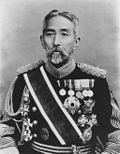Imperial Japanese Army
The Imperial Japanese Army (Japanese ; 大日本帝国陸軍, Dai-Nippon Teikoku Rikugun), also known as the IJA, was the army of Imperial Japan from 1868 to 1945.[1] The army was under the command of Emperor Meiji from 1868-1912, Emperor Taishō from 1912-1926, Emperor Hirohito from 1926-1945, and Hideki Tōjō from 1884-1948.
The IJA was started after the Meiji Restoration in 1868, replacing the Samurai. It was abolished at the end of World War II in 1945.[2]
The army was involved in many Wars : Boshin War (1868-1869) Invasion Of Taiwan (1874) Shinpuren Rebellion (1876) Satsuma Rebellion (1877) First Sino-Japanese War (1894-1895) Invasion Of Taiwan (1895) Boxer Rebellion (1899-1901) Russo-Japanese War (1904-1905) World War 1 (1914-1918) Siberian Intervention (1918-1922) Japanese Invasion Of Manchuria (1931) Soviet-Japanese Border Conflict (1932-1939) Second Sino-Japanese War (1937-1945) Battle of Khalkhin Gol (1939) World War 2 (1941-1945) .
Legacy
Article 9 of the Constitution of Japan prohibits the use of aggressive force as a means for settling international disputes.[3]
In order to defend Japan, if necessary, the Japan Self-Defense Forces (JSDF) was formed.[4]
The ground-reach of JSDF is the Japan Ground Self-Defense Force (JGSDF).[5]
Imperial Japanese Army Media
Battle of Toba–Fushimi, The Great Victory of the Government Forces of Mori (Chōshū), Shima (Satsuma), and Yama (Tosa). Nishiki-e, depicting the retreat of shogunate forces in front of the Imperial Army (Kangun). Yodo Castle is shown in the background. (Japanese title: Mori Shima Yama kangun daishōri no zu).
The Koishikawa Arsenal in Tokyo, inaugurated in 1871, soon after the Meiji restoration
Prince Aritomo Yamagata, a field marshal in the Imperial Japanese Army and twice Prime Minister of Japan. He was one of the main architects of the military foundations of early modern Japan. Yamagata Aritomo can be seen as the father of Japanese militarism.
Marquis Nozu Michitsura, a field marshal in the early Imperial Japanese Army. He was appointed as chief of staff of the Imperial Guard (Japan) in 1874.
Marquis Jutoku Saigo, a general in the early Imperial Japanese Army and the nephew of Saigō Takamori, the leader of the Satsuma Rebellion of 1877. Many of the rebels were incorporated into the Imperial Army after the failure of the armed uprising.
Commander-in-chief Saigō Tsugumichi (sitting at the center) pictured with leaders of the Seqalu tribe
Count Nogi Maresuke, a general in the Imperial Japanese Army and the third governor of Taiwan
Type 13 (top) and Type 22 (bottom). The Murata rifle is the first locally produced Japanese service rifle that was adopted in 1880.
Related pages
References
- ↑ Nussbaum, Louis-Frédéric. (2005). "Rikugun-shō" in Japan Encyclopedia, p. 790.
- ↑ Library of Congress Country Studies, Japan (LOC), "World War II and the Occupation, 1941-52". Retrieved 2012-2-22. Archived 2007-07-12 at the Wayback Machine
- ↑ LOC, "The Article 9 'No War' Clause". Retrieved 2012-2-22.
- ↑ LOC, "The Self-Defence Forces" (JSDF). Retrieved 2012-2-22.
- ↑ LOC, "Ground Self-Defense Force" (JMSDF). Retrieved 2012-2-22.
Other websites
| Wikimedia Commons has media related to Lua error in Module:Commons_link at line 62: attempt to index field 'wikibase' (a nil value).. |
- AxisHistory.com, Japanese Army
- Imperial Japanese Army -Citizendium








